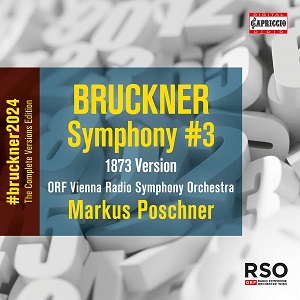
Anton Bruckner (1824-1896)
Symphony No 3 in D minor (orig. 1873 version)
ORF Vienna Radio Symphony Orchestra/Markus Poschner
rec. 2022, Radio Kulturhaus and Konzerthaus, Vienna
Capriccio C8086 [57]
Like many other latter-day conductors, Markus Poschner seems determined to “get on with” Bruckner. The tempi move: no searches for profundity here. The climaxes arrive forthrightly – sometimes, they could have used a bit more of a setup – and even the composer’s notorious general pauses feel compressed, contracted somehow. The effects on some of Bruckner’s compositional tics, like syncopations, are inconsistent: those in the Andante-ish Adagio feel pushed along, but the Finale‘s tutti pulses make more sense at the brisker pace.
Still, Poschner makes most of it work, at least ‘in the moment’. He’s sensitive to the varying moods of the music – the lyrical themes blossom – and, unlike many other “horizontal” Bruckner conductors, he never lets the music feel inappropriately light: his deliberate, purposeful shaping of the climaxes invests them with the necessary tonal weight.
The symphony’s opening moves swiftly, directly into the unison peak. The second group, where the intertwining string parts sing easily, maintains the same basic pulse. Despite the general motility, the back-and-forth chords of the development get stuck for a bit; after the sense of motion resumes, the hurtling passage is effective, with an emphatic landing on the false recap.
The Adagio‘s opening chorale is pretty; it lacks the customary breadth, but Poschner instead uses colour and texture to suggest the movement’s spiritual quality. The cellos introducing the second theme are luminous, but the third theme’s long “tails” sound busy-busy at this speed. The Scherzo brings the usual whirling motion and drive, but Poschner only slows slightly for the rustic Trio, leaving it breathless.
I liked the quiet, anticipatory rush at the Finale‘s start; the second group, significantly faster than most, still projects a rustic mood. The quiet part of the development, unfortunately, still rambles; the coda is paced well, but the ending sounds abrupt, even for Bruckner.
Sonics are full and wide-ranging, with good localization of the various string sections, though the resonant ambience gives high trumpet notes a bit of an edge.
Stephen Francis Vasta
stevedisque.wordpress.com/blog
Previous reviews: Ralph Moore (October 2022) ~ Gregor Tassie (December 2022)
Help us financially by purchasing from




















